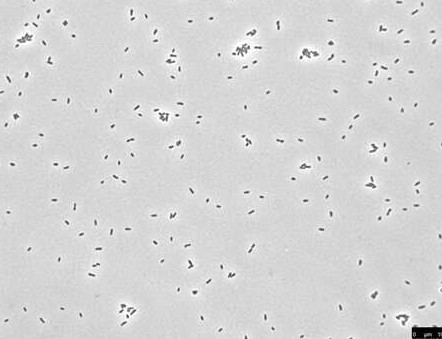Brucellosis is an agricultural and human health concern on a global scale. It was introduced over 100 years ago to Bison and elk in Yellowstone National Park by cattle and has been circulating among the wild herds ever since, leading to periodic outbreaks and reinfection. There is no vaccine for humans, and experimental studies of B. abortus in its natural animal hosts are technically difficult, extremely expensive and only a few facilities are capable of conducting these studies.
That did not stop Sean Crosson, MSU Rudolph Hugh Endowed Professor, and colleague Aretha Fiebig, research associate professor in Michigan State University's Department of Microbiology and Molecular Genetics, from bringing sophisticated genomics tools from the lab to the field to gain new insight into how B. abortus infects cattle and help stop the spread of this deadly disease.
The results of their study were published in the Proceedings of the National Academy of Sciences.
"B. abortus primarily infects cattle, causing pregnant cows to abort the fetus, but the infection is typically studied in mouse models, which are not the true host of the bacterium," explained Crosson, who has been studying the bacteria for more than 14 years. "If you want to understand the infection biology underlying bovine disease, then it's helpful to study things in the natural host in a field context."
In the microbiological equivalent to tagging cattle, Crosson and Fiebig harnessed the hopping ability of specialized DNA called transposons to tag individual strains of B. abortus with unique barcodes. This gave them the ability to count how many B. abortus bacteria made it from the cow's eye, a common point of infection in the field, to the lymph nodes.
"As molecular biologists, we can harness hopping DNA by separating away the enzyme that allows it to continue moving," said Fiebig, who specializes in bacterial regulatory mechanisms. "We temporarily gave DNA the ability to hop into the B. abortus genome, but it didn't hop out again."
The scientists mixed millions of E. coli bacteria carrying transposons with millions of B. abortus in a broth containing amino acids and sugars, initiating mass tagging through a process called bacterial conjugation where transposons hop into and unite with the B. abortus genome. When the remaining E. coli cells were washed away, they were left with a vat of individually barcoded B. abortus strains.

Image of Brucella abortus cells captured by light microscopy (magnified 630x). Each of these cells contain a short, unique DNA sequence, or “barcode”, that enables the identification of individual strains in a mixed population.
"We were able to make a rich pool of about a million different barcoded strains," Fiebig said. "When we infected the cattle, we could track almost every single strain and ask, 'how many strains got lost, what strains had an advantage and was that advantage for a genetic reason or just chance?'"
Click here to see more...